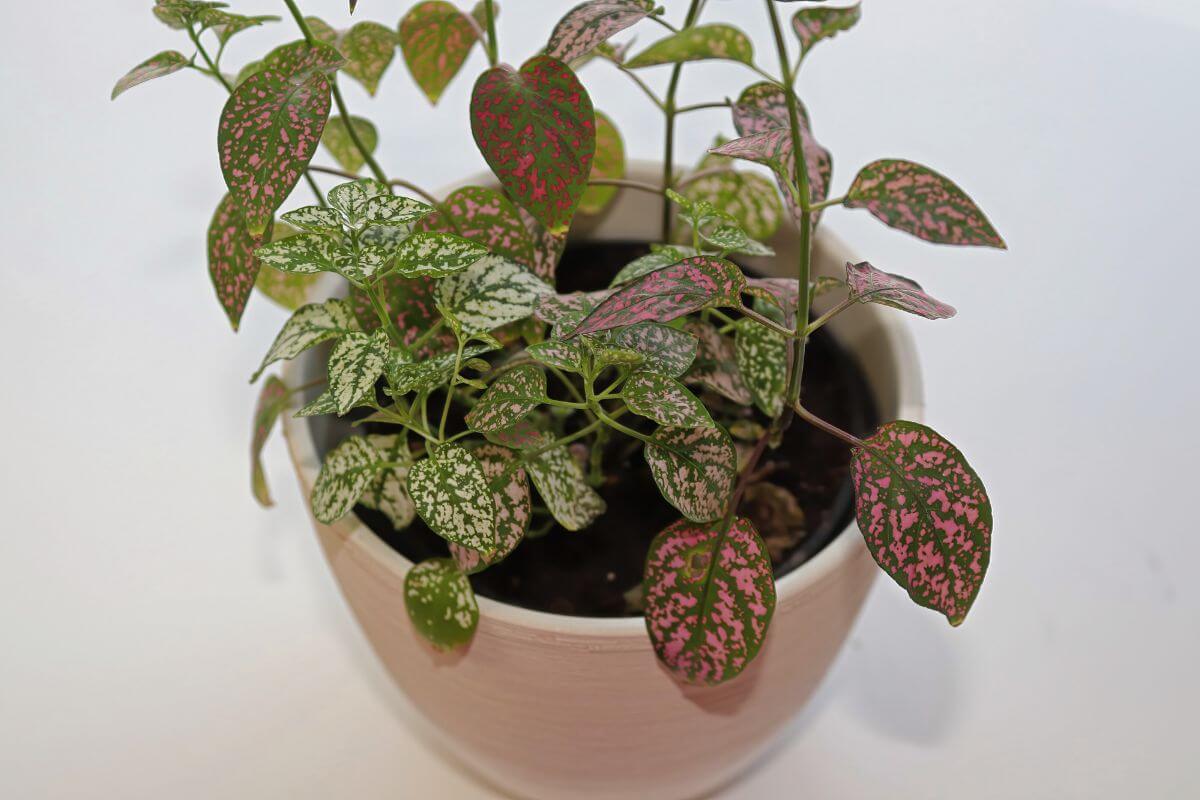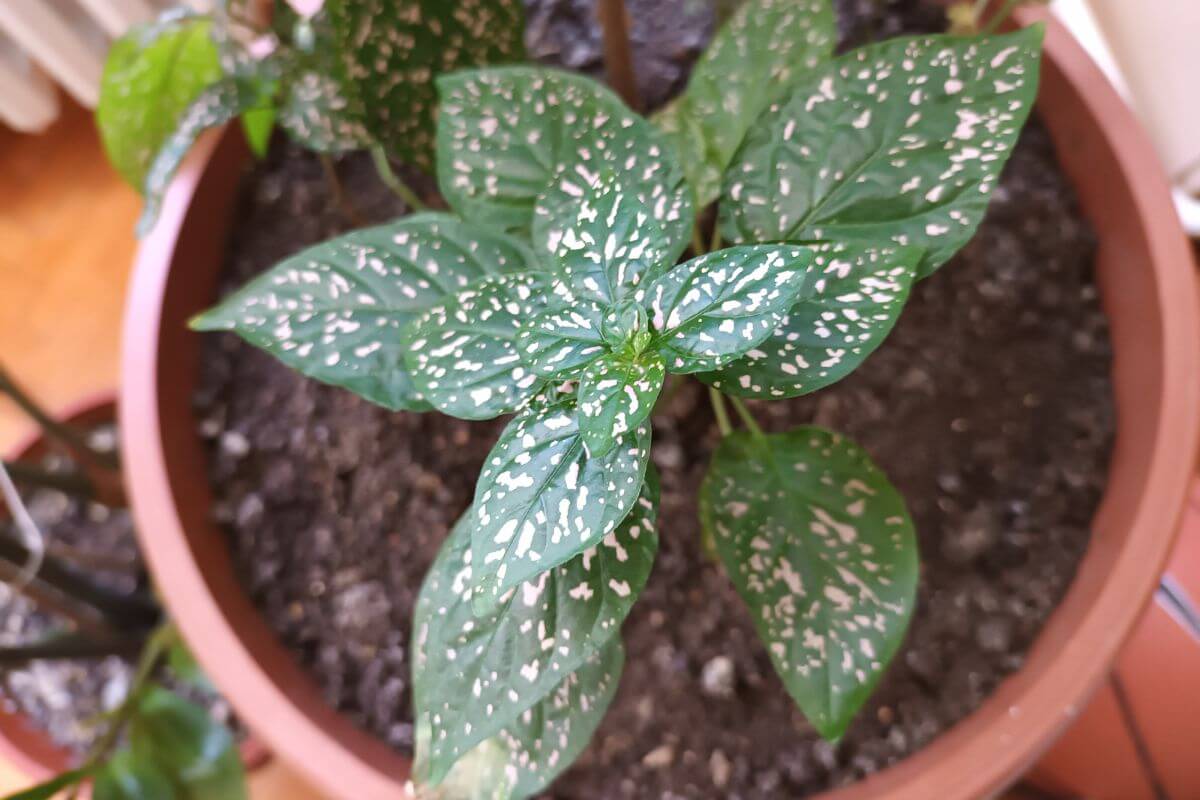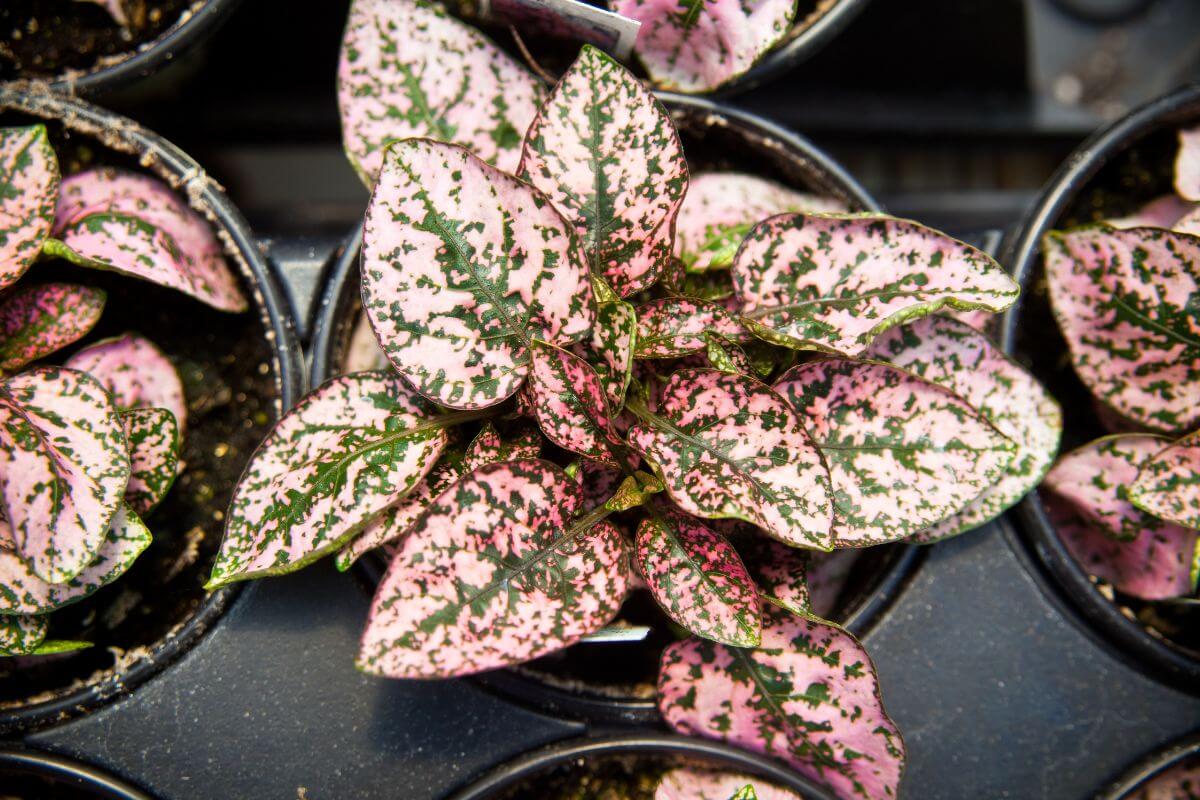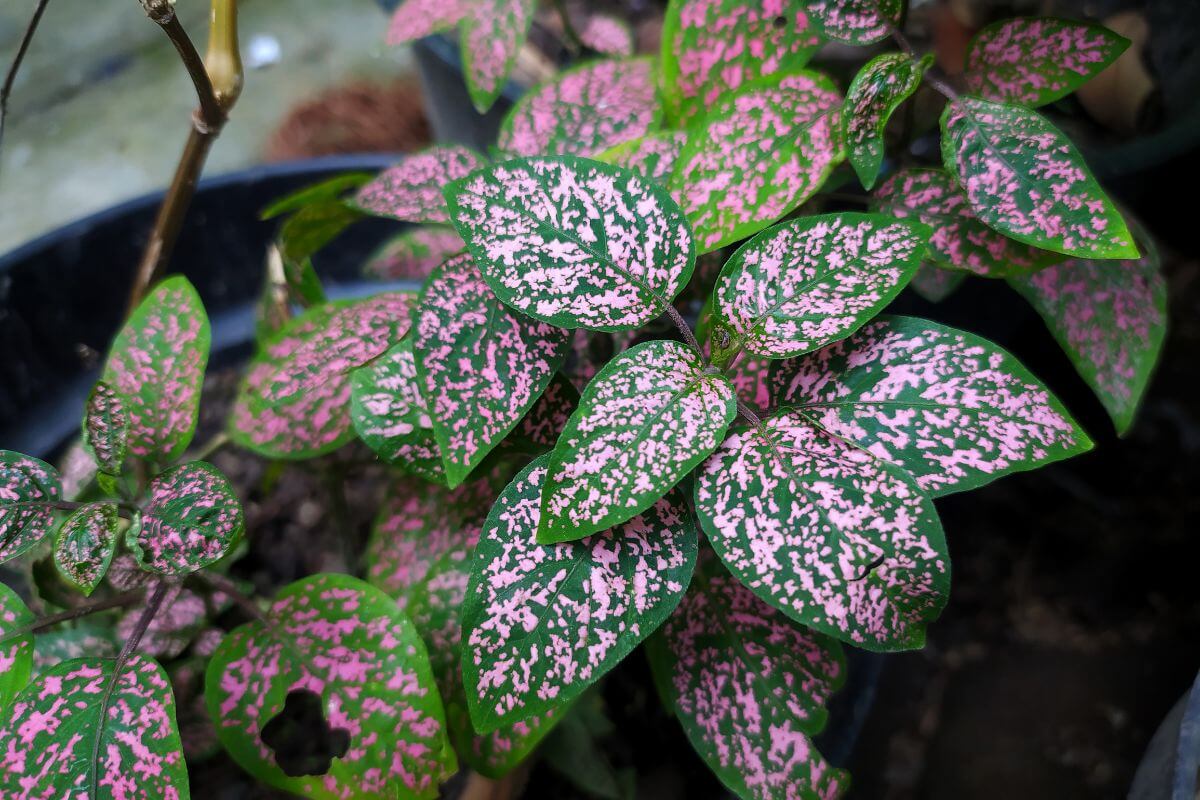The Polka Dot plant (Hypoestes phyllostachya), a herbaceous perennial is native to Madagascar. It is a lively, colorful addition to any indoor garden at home.
This article will discuss everything about these beautiful houseplants and how to care for the polka dot plant.
Polka Dot Plant Overview

A member of the Acanthaceae family, the polka dot plant has spotted leaves that contrast beautifully with the typically green foliage of other plants.
Other names for this plant include the measles plant, pink dot plant, flamingo plant, or freckle face plant.
There are more than one hundred polka dot plant varieties, including:
- “Camina” with red spots on a dark green background.
- “Confetti” features green leaves with white, burgundy, rose, pink or red dots.
- “Pink Brocade” boasts green leaves with pink dots that are mottled.
- “Purpuriana” will have purplish foliage, hence the name.
- “Splash” with various greens splotched with white, pink, or red.
- “Wit” features white leaves that are marbled.
While the popular version typically sold in nurseries may feature pink leaves with bright green spots, it can also be found with white, red, or purple spots among other colors. Some breeders have created cultivars with stronger, deeper colors as well.
These plants are not difficult to cultivate. However, because they are warm-climate plants, they are often raised as annuals and then replaced the following year.
They also thrive as houseplants and remain small when cultivated indoors. It is best to plant them in the springtime. Their growth rate is quick too, so you won’t need to wait long for them to grow.
In its native Madagascar, the polka dot plant can grow to be about three feet tall and wide. Indoor plants will be smaller. As the plant matures, it will become woody and somewhat spindly.
Polka Dot Plant Care Guide
For a happy polka dot plant, warm environmental temperatures paired with humidity are the successful formula. Outdoors, your polka dots will require regular watering unless you reside in an area with adequate rainfall.
They also require fertilizing throughout their growing season, from spring to autumn. For outdoor gardens, this is a non-invasive plant and will do well next to other shrubs and flowers.
As these plants can get leggy, it is wise to snip off the top two leaves on every stem weekly. This will promote a bushier appearance.
Occasionally, the polka dot will bloom in the summer, producing lilac flowers on spikes that are not showy. These flower spikes can be removed, so they don’t drain energy from foliage development.
Soil for the Polka Dot Plant

Organically rich, loamy soil is the preferred soil for the polka dot. Like many other houseplants, it must be well-draining soil.
A standard all-purpose potting mix can be used with a bit of perlite or pumice mixed in to ensure drainage.
Polka dots will thrive with a soil pH level in the range of 5.5 to 6.5.
Light for the Polka Dot Plant
If you are cultivating polka dot plants outdoors in your garden, choose a location that offers partial shade. If the position for planting is too bright with sunlight, the foliage will fade.
Indoors, give your polka dot plant bright indirect light. They can do well in low light conditions, but may lose some variegation.
Water and Humidity for the Polka Dot Plant
The soil for the polka dot needs to be moderately moist at all times. Do not let the soil dry out. With a lack of moisture, its leaves will wilt, and your polka dot will suffer. Moist yes, soggy never!
If you allow the soil to become waterlogged, the plant is at risk of root rot, which can be fatal. When the soil that’s a half-inch deep is dry, water your plant.
Plants cultivated in pots indoors will require more frequent watering than outdoor plants. Watering can be reduced in the wintertime and then increased when spring rolls around.
The polka dot likes humidity! The minimum level for humidity should be no lower than 50%. If you do not have sufficient humidity where your plant is positioned, use a humidifier, or a tray filled with pebbles and water.
The plant should sit on the tray but above the waterline. The pot should not come into contact with the water at all. As the water evaporates, humidity will increase.
A bowl of water can also be placed near the plant. Other helpful actions include misting often or grouping plants together that enjoy humidity. This will all help to add humidity.
The fastest and simplest way to increase humidity is by spraying your polka dot plant with a fine mist of water. Rainwater is ideal because it will not have chemicals as tap water does. Always make sure the water is tepid when misting. The best place for misting is over a sink or bathtub or in a shower.
Another great option is to place the polka dot plant in the bathroom. The hot showers will add humidity, especially during dry winters.
Temperature for the Polka Dot Plant
Outdoor polka dot plants thrive in temperatures that range from 70° to 80°Fahrenheit. They do not tolerate temperatures that fall below 60°F.
They can be planted in the spring once the last frost has passed. At the end of the growing season, bring them inside before the autumn’s first frost.
Keep your indoor plant away from radiators or heating vents as well as air conditioning vents. If you have floor heating, keep your plants raised on a table or plant stand.
Avoid positioning them near doorways and corridors where cold drafts are more common. Humidity could also be lower in these areas due to air circulation.
If you are growing polka dot plants outside and live in an area with colder winters, you should treat them as if they are annuals. Place them in pots and move them indoors in the autumn.
Fertilization for the Polka Dot Plant
Polka dot plants like to eat, so they should be fed once a month when cultivated indoors with an organic fertilizer.
Outdoors, you can guarantee adequate nutrition by mixing a layer of compost into the soil bed.
Pruning and Repotting the Polka Dot Plant

Mature polka dots have a tendency to become leggy with age. This can be controlled by pruning the canes back to a lower height. The plant will fill in for a bushier look.
It is also wise to pinch off the top two leaves on the stems weekly to keep your plant from growing in length and thinning out.
Older polka dot plants can be repotted in the spring or summer if they have outgrown their pots.
Propagating the Polka Dot Plant
When propagating a polka dot plant, you can choose between using seeds or stem cuttings.
To seed your plants, sew them in the early spring by positioning them on top of a soil bed that is warm and moist. They should begin to germinate after a few days and the new seedlings can be transplanted into the chosen soil bed in several weeks.
To propagate with cuttings, snip off a stem length near a node that is approximately five inches long from the mother plant. Remove the leaves closest to the snipped end. Coat the cut end with rooting hormones and place it in warm moist soil. After about a week, the roots should sprout.
Polka Dot Plant Toxicity and Pets
According to the American Society for the Prevention of Cruelty to Animals (ASPCA), the polka dot is non-toxic for both cats and dogs and for horses. However, if eaten, it can cause diarrhea and some vomiting.
For outdoor gardeners, this is a plant resistant to deer.
Polka Dot Plant Pests, Diseases, and Problems

The polka dot plant, like many other houseplants, can fall prey to aphids, mealybugs, scale, spider mites, and whiteflies.
The foliage may become discolored and show holes. You may even notice bugs moving along the plant. Spider mites will create small webbing between the stems and leaves.
An organic pesticide, such as neem oil, is ideal when dealing with houseplant pest infestations. When applying neem oil, take the plant outdoors to spray it to avoid inhaling vapors.
Indoor polka dots that are not cultivated in ideal conditions tend to be more at risk for pest infestations than outdoor plants grown in the correct environmental conditions.
The foliage will tell you a lot about the general health of your plant.
- If your polka dot appears to be losing its spots or leaves are fading, this will most likely be due to light that is too direct or strong. They do need bright light to retain their vivid colors, but it should be indirect.
- Yellow leaves indicate overwatering.
- Drooping leaves indicate thirst and underwatering.
- A scorched or curled leaf has received too much direct sun exposure. UV rays will burn foliage.
Polka Dot Plant Care Final Thoughts
The polka dot plant is a decidedly perky plant in appearance with its beautiful color variations that are easy to grow. It looks wonderful in the midst of other green foliage and can be a stunning curb trim for your garden.
It is often included in groupings of plants just for this reason. Its unique foliage will add a bit of pizzazz to your indoor décor or color to your outdoor garden.
For other great houseplants to grow at home, check these guides:
- Polka Dot Begonia Care Guide
- Swiss Cheese Plant Care Guide
- Shamrock Plant Care Guide
- Wandering Jew Plant Care Guide
Polka Dot Plant Care FAQs
How much sun does a polka dot plant need?
The polka dot plant likes moderate amounts of sunlight. As long as it’s bright indirect light, it’ll be a happy plant. Give it 8-10 hours of light each day.
How do you care for a polka dot plant indoors?
Caring for the polka dot plant indoors is very similar to caring for any other houseplant. Water regularly during dry spells. Keep the potting mix slightly damp, so water doesn’t sit on top of the dirt. If necessary, use a plant humidifier to keep the humidity high enough. This keeps the air humid without saturating the soil.
How often should I water my polka dot plant?
The polka dot plant should be watered every week or two if kept inside all year round. During winter months, give them an occasional misting instead of regular watering. As your local environment climate will also impact how often you water your plants, check for dryness in the top half-inch of soil, as that will be when you need to water.
Do polka dot plants come back every year?
Yes, polka dot plants come back every year. They complete a life cycle within a year, but if you grow them indoors, the short lifespan can be prolonged. The best way to prolong the life span of your polka dot plant is by keeping it healthy and well fed. You may want to repot your plant once a year to ensure proper root development. Repotting can help prevent disease from spreading throughout the roots too.
Should I mist my polka dot plant?
Yes, you should mist your polka dot plant because they like moisture. A good rule of thumb is to mist your plant weekly or biweekly during summer months. Mist only the upper portion of the plant; don’t let the water get into the bottom part of the pot where the roots reside, to avoid overwatering Use a spray bottle filled with room temperature water.
Why is my polka dot plant flowering?
Your polka dot plant is flowering because it has reached maturity. After flowering, it will enter its dormancy period or die. When growing outdoors, most varieties flower between late spring and early fall. Indoor growers have more control over their growth cycles, which means they can extend the time frame until flowers appear. Some varieties even bloom continuously throughout the entire season. To encourage continuous blooming, remove spent blossoms before new ones emerge.


